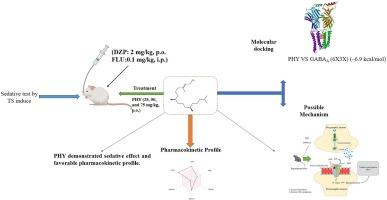植物醇具有类似镇静剂的作用,可调节地西泮和氟马西尼的作用,可能是通过 GABAA 受体相互作用途径。
IF 2.5
4区 医学
Q3 NEUROSCIENCES
引用次数: 0
摘要
本研究旨在通过体内和硅学研究评估植物醇(PHY)的镇静作用和可能的分子机制。为此,将成年雄性小鼠随机分为六个独立的组,即对照组(载体)、两个标准组(DZP:地西泮,2 毫克/千克;FLU:氟马西尼,0.1 毫克/千克)、三个试验组(PHY,25、50 和 75 毫克/千克)以及三个 DZP-2 和/或 FLU-0.1 与 PHY-75 毫克/千克的混合组。30 分钟后,对每只动物注射 40 毫克/千克的硫喷妥钠(TS)以产生镇静作用,并观察其睡眠潜伏期和持续时间长达 4 小时。对 GABAA 受体 α1 和 β2 亚基的 6X3X 蛋白进行了硅学研究。研究结果表明,PHY 可剂量依赖性地延长动物的睡眠时间。然而,与对照组和标准组相比,它产生的睡眠时间并不显著。此外,PHY 还能明显(p A 受体)延长动物的睡眠时间。PHY 可能是治疗失眠等睡眠障碍的良好候选药物之一。本文章由计算机程序翻译,如有差异,请以英文原文为准。

Phytol exerts sedative-like effects and modulates the diazepam and flumazenil’s action, possibly through the GABAA receptor interaction pathway
This study aimed at the evaluation of the sedative effect of phytol (PHY) with possible molecular mechanisms through in vivo and in silico studies. For this, adult male mice were randomly divided into six individual groups, namely control (vehicle), two standards (DZP: diazepam at 2 m/kg, FLU: flumazenil at 0.1 mg/kg), three test groups (PHY at 25, 50, and 75 mg/kg), and three combined groups with the DZP-2 and/or FLU-0.1 with PHY-75 mg/kg. After thirty minutes, each animal was treated with thiopental sodium (TS) at 40 mg/kg to produce sedation and observed for latency and duration of sleep up to 4 h. In silico studies were performed with the 6X3X protein of the GABAA receptor α1 and β2 subunits. The results demonstrate that PHY dose-dependently enhanced sleep duration in animals. However, it produced an insignificant sleep duration compared to the control and standard groups. It also significantly (p < 0.05) decreased the latency and increased the duration of sleep with DZP-2, while reducing these parameters with FLU-0.1. In in silico studies, DZP and FLU exhibited binding affinities with 6X3X by −6.8 and −6.9 kcal/mol, respectively, while PHY exhibited −6.9 kcal/mol. Taken together, PHY may exert a sedative-like effect in TS-induced sleeping mice and modulate the effects of DZP and FLU, possibly through interacting with the 6X3X protein of the GABAA receptor. PHY may be one of the good candidates for the management of sleep disturbances, such as insomnia.
求助全文
通过发布文献求助,成功后即可免费获取论文全文。
去求助
来源期刊

Neuroscience Letters
医学-神经科学
CiteScore
5.20
自引率
0.00%
发文量
408
审稿时长
50 days
期刊介绍:
Neuroscience Letters is devoted to the rapid publication of short, high-quality papers of interest to the broad community of neuroscientists. Only papers which will make a significant addition to the literature in the field will be published. Papers in all areas of neuroscience - molecular, cellular, developmental, systems, behavioral and cognitive, as well as computational - will be considered for publication. Submission of laboratory investigations that shed light on disease mechanisms is encouraged. Special Issues, edited by Guest Editors to cover new and rapidly-moving areas, will include invited mini-reviews. Occasional mini-reviews in especially timely areas will be considered for publication, without invitation, outside of Special Issues; these un-solicited mini-reviews can be submitted without invitation but must be of very high quality. Clinical studies will also be published if they provide new information about organization or actions of the nervous system, or provide new insights into the neurobiology of disease. NSL does not publish case reports.
 求助内容:
求助内容: 应助结果提醒方式:
应助结果提醒方式:


